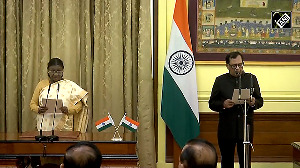Although India's headline growth rates appear flattering, that is in part the result of change in statistical methods that seek to capture more evidence of economic activity.

India's economic growth likely picked up in the July-September quarter, outpacing China on improving domestic demand and manufacturing activity that could persuade the Reserve Bank of India to keep interest rates unchanged on Tuesday.
Asia's third-largest economy likely expanded 7.3 per cent in the second quarter of the current financial year 2015/16 that ends in March, compared with 7 per cent in April-June, according to analysts polled by Reuters.
The data will be released on Monday at around 5:30 p.m.
Stronger growth would be a boost for Prime Minister Narendra Modi after a defeat in state elections of India's third-most populous state of Bihar.
Modi is focussing on reforms to accelerate growth and hopes to convince his opponents to implement a much-delayed national sales tax in 2016.
Analysts say the goods and services tax - which seeks to unify India's 29 states into a single market - could help raise GDP growth to around 8 per cent in the next fiscal year.
"Higher government capital spending, as well as efforts to facilitate clearances and simplify approvals have contributed to a pickup in investment activity," said Aditi Nayar, an economist at ICRA, the Indian arm of credit rating agency Moody's.
But she said that the recovery has yet to widen beyond select sectors since cheaper imports and shrinking exports will act as a drag on corporate investment this year.
A drought in parts of the country for the second straight year has hurt farm output and rural wages - hitting demand for farm machinery like tractors as well as consumer goods.
Although India's headline growth rates appear flattering, that is in part the result of change in statistical methods that seek to capture more evidence of economic activity.
Other barometers such as bank credit growth, jobs and consumer demand paint a less healthy picture, analysts say.
WINDFALL GAIN
While most emerging economies from Brazil to Russia are struggling amid global headwinds and China's slowdown, India remains a bright spot due to its divergent economy and windfall gains from a plunge in commodity prices.
Sharp falls in the cost of oil and gold imports are reducing the trade deficit and giving a net boost to economic activity.
Manufacturing, which accounts for about 18 per cent of the economy, grew 4.2 per cent in the first half of the current financial year, compared with 2.2 per cent a year ago.
But exports of goods shrank by nearly a quarter in September from a year ago, falling for a 10th straight month, prompting the government to extend subsidised credit to exporters.
Still, India's economy is mostly driven by domestic demand, and a hike of over 16 per cent in wages of near 10 million government employees and pensioners from January could boost consumer spending.
India's central bank is expected to keep interest rates unchanged when it meets on Tuesday, after a sharper than expected 50 basis point cut at its last meeting, as it looks to control price rises ahead of a tighter 2016 inflation target.
Consumer inflation in India cooled to record lows earlier this year but crept back to a four-month high of 5.0 per cent in October.
RBI has also been cautious ahead of an expected rate increase by the US Federal Reserve, which meets in mid-December.
"Barring an unexpectedly feeble GDP data print on Monday, we expect the RBI to hold rates unchanged in the December 1st policy review," Nayar said.










